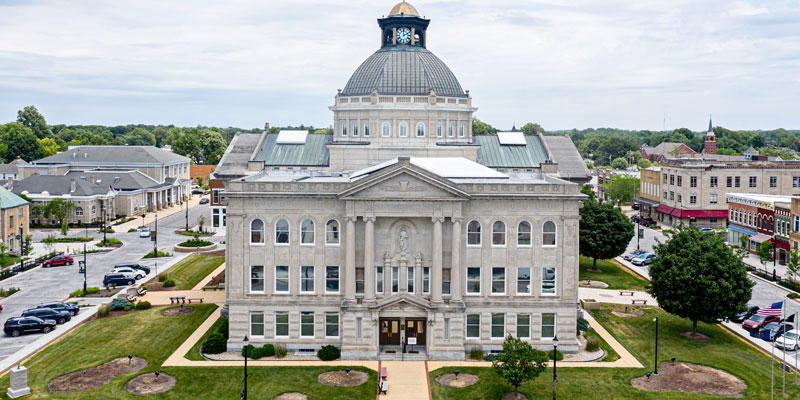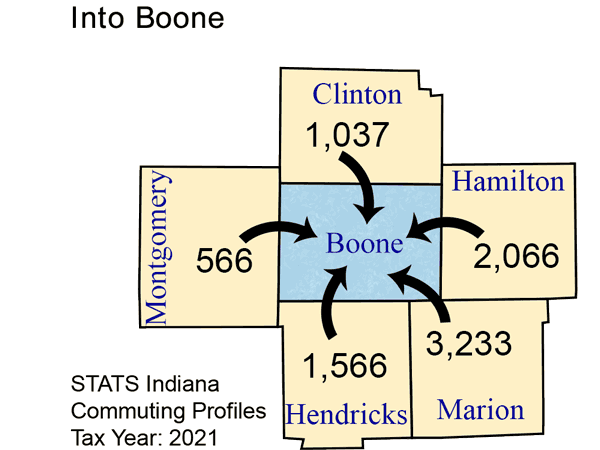
New investments in Boone County spark growth
Education and Workforce Analyst, Indiana Business Research Center, Indiana University Kelley School of Business
Over the past couple of years, there have been multiple investment announcements in and around Boone County. These include Eli Lilly, NewCold and Iwis Drive Systems, among others. In this article, we are looking at the labor shed that includes Boone, Clinton, Hamilton, Hendricks, Marion and Montgomery counties. These counties share borders as well as a labor market, with more than 10,000 residents of surrounding counties commuting into Boone County for work and driving the I-65 corridor from the south and the north and right through Boone County (see Figure 1).
Figure 1: Top five counties sending workers into Boone County, 2021

Source: IBRC, using Indiana Department of Revenue data (IT-40 tax returns)
The region’s population growth is strong
The region surrounding Boone County is growing its population much faster than the state overall – a rate of 14.5% growth since 2010 as compared to growth of 5.4% in Indiana and 7.9% in the U.S. Plus, this region has a well-educated population, with 25% of its adults having earned a bachelor’s degree as opposed to 17.7% in Indiana and 20.6% in the U.S. Table 1 provides a breakdown of demographic characteristics of the entire region, Boone County alone, the state of Indiana and the United States.
Table 1: Population and demographic characteristics
| Indicator | "Greater Boone County" region | Boone County | Indiana | United States |
|---|---|---|---|---|
| 2022 Population | 1,662,201 | 74,164 | 6,833,037 | 333,287,557 |
| Population growth, 2010 to 2022 | 14.5% | 30.9% | 5.4% | 7.9% |
| % with associate degrees | 7.8% | 9.1% | 9.0% | 8.7% |
| % with bachelor's degrees | 25.0% | 30.9% | 17.7% | 20.6% |
| Per capita income | $69,416 | $84,985 | $56,497 | $64,143 |
| Unemployment rate | 3.4% | 2.9% | 3.6% | 3.8% |
| Employment growth, 2021 Q1 to 2023 Q1 | 7.1% | 11.6% | 5.7% | 8.2% |
| % Goods-producing jobs | 14.8% | 15.9% | 23.7% | 15.6% |
| % Service-providing jobs | 85.2% | 84.1% | 76.3% | 84.4% |
Source: U.S. Census Bureau annual population estimates; U.S. Census Bureau, American Community Survey, 2021 5-year estimates; U.S. Bureau of Economic Analysis 2021 data; U.S. Bureau of Labor Statistics, Local Area Unemployment Statistics (LAUS) for August 2023 and Quarterly Census of Employment and Wages (QCEW) 2023 Q1 data
The Greater Boone County economy
The region is also doing well relative to Indiana and the U.S. on some measures of economic prosperity. Its per capita income is $69,416, compared to $56,497 for Indiana and $64,143 for the U.S. Its unemployment rate (3.4%) is just slightly lower than Indiana’s (3.6%) as of August 2023.
The region’s largest industry sectors by employment include health care and social services (14.5%), retail trade (9.4%), administrative and support and waste management and remediation services (8.6%), transportation and warehousing (8.3%) and manufacturing (8.2%). These five sectors combined for nearly 424,000 employees in 2021, almost half of the region’s total employment of 864,787. The region’s most productive sectors in terms of current-dollar GDP in 2021 are manufacturing ($24.5B, 20.1% of the region’s total GDP), real estate and rental and leasing ($19.7B, 16.1%), and health care and social services ($10.7B, 8.8%).
Current job demand in the region
To get an indication of real-time job demand, we considered the volume and intensity of job postings in the region from January to July 2023. Over this seven-month period, there were a total of 622,451 job postings, of which 167,589 were unique, according to Lightcast™, the commercial labor analytics company. The median job was posted for 32 days at an advertised salary of $50,000, an increase of 16.5% since August 2022. See Table 2 for the five occupations with the largest number of unique job postings for the year through July.
Table 2: Top posted SOC-detailed occupations in Greater Boone County
| SOC | Occupation title | Unique postings | Postings % change (1/23 to 7/23) | Posting intensity | Median posting duration | Median hourly earnings | Hourly median advertised wages |
|---|---|---|---|---|---|---|---|
| 29-1141 | Registered nurses | 9,770 | -22% | 7:1 | 32 days | $37.26 | $54.28 |
| 41-4012 | Sales representatives, wholesale & manufacturing, except scientific & technical products | 4,202 | -31% | 3:1 | 31 days | $31.44 | $31.20 |
| 41-2031 | Retail salespersons | 3,596 | -12% | 3:1 | 33 days | $14.45 | $16.06 |
| 53-3032 | Heavy & tractor-trailer truck drivers | 3,495 | 33% | 7:1 | 33 days | $26.17 | $37.60 |
| 43-4051 | Customer service representatives | 3,111 | -37% | 3:1 | 31 days | $18.97 | $17.54 |
Source: Lightcast™ and Bureau of Labor Statistics data
Job postings are down across the board, with customer service representatives experiencing the greatest decline with 37% fewer unique postings in July compared to January. Posting intensity refers to the volume of cross-postings of the same job; for example, a posting intensity of 3:1 means that there are three times as many total postings as unique postings. It’s a proxy for employer demand for talent and how hard the job is to fill.
Another sign of demand is the difference between the median hourly earnings of a job, which is based on Bureau of Labor Statistics (BLS) wage data, and the median hourly advertised wage, which is the wage amount stated in the posting. When the advertised wage is higher than a job’s median earnings, it’s an indication the job may be hard to fill so employers are forced to advertise a higher wage. Nurses and tractor-trailer drivers have the highest discrepancy between BLS hourly earnings and advertised wages, as well as the highest posting intensity, indicating these are high-demand and hard-to-fill jobs.
Conclusion
Since the pandemic, there have been dozens of new investment deals happening throughout Indiana. Boone County has been in the media spotlight recently due to a number of potential investment deals in the area, which seems particularly ripe for development considering its proximity to the I-65 corridor and the new LEAP Innovation District, coupled with growth in population and jobs. As deals intensify, the need for skilled workers is simultaneously intensifying. Being able to anticipate those needs accurately was described in an article earlier this year in the Indiana Business Review, Projecting jobs growth from capital investment.
Though the Boone County labor shed is well-positioned for high-skilled jobs growth given its relatively high educational attainment, the sheer volume of deals and the kinds of jobs they would create highlight the need to invest in efforts to further increase educational attainment and arm workers with industry-aligned skills. This would require a combination of quality-of-life investments in the region to draw highly educated residents from elsewhere, as well as skilling up current residents and workers. The region and the state must commit to building education capacity through bolstering enrollment in traditional degree programs in addition to skills-based certificates, micro-credentials, apprenticeships and more to cultivate a competitive and agile workforce.



